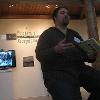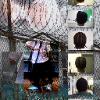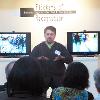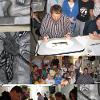Engagement, motivation, and self-reflection.
These terms are found at the very core of my teaching and are critical in my unique approach toward pedagogy within the visual arts. They have formed the foundation and backbone of my instructional repertoire during the last twenty years as a First-Year Experience (FYE) faculty member at the Milwaukee Institute of Art & Design. My steadfast passion for visual arts education at the collegiate level has never been stronger. Engaged, motivated, and self-reflected learning is especially important with curricular content that employs integrated and time-based aspects. According to master educator Madeline Hunter - teachers cannot ‘motivate’ their students, however, they can develop an environment that fosters motivation. The idea of ‘environmental fostering’ and building developmental assets to encourage, intensify, and create motivation within the studio is paramount in the management of my students.
The endless enthusiasm I have for my students and their work is largely because I love the content of what I am teaching. Establishing an atmosphere where engaged, energized learning can occur is paramount. By encouraging motivation and nurturing self-reflection, I have seen improvement in student work ethic, self-confidence, and independence in the studio. What benefits from this pairing is the open sharing of their creativity and ideation as well as an eagerness to continue working and learning. This notion is echoed in Hunter’s mantra of testing for knowledge in the classroom, and before a student progresses further into the ‘unknown’ a teacher should assess for learning. Similar to the structures found within Design Synectics, the cycle of learning beginning with ideation and resulting with self-reflection is critical in the studio, regardless of content.
Determining how these students are engaged is also essential aspect in the learning process. With the emergence of the new millennial mindset, learning has been transformed into a more direct and tailored experience focused upon the individual and their choices. I have found that if their interest in the studio is lost, then so is their motivation. No motivation results in minimal work and an inadequate self-reflection with minimal learning. No amount of enthusiasm will earn that back. Encouraging students to see themselves within the lesson is critical, as is the act of locating themselves within the larger constraint of visual culture and seeing themselves as cultural producers.







